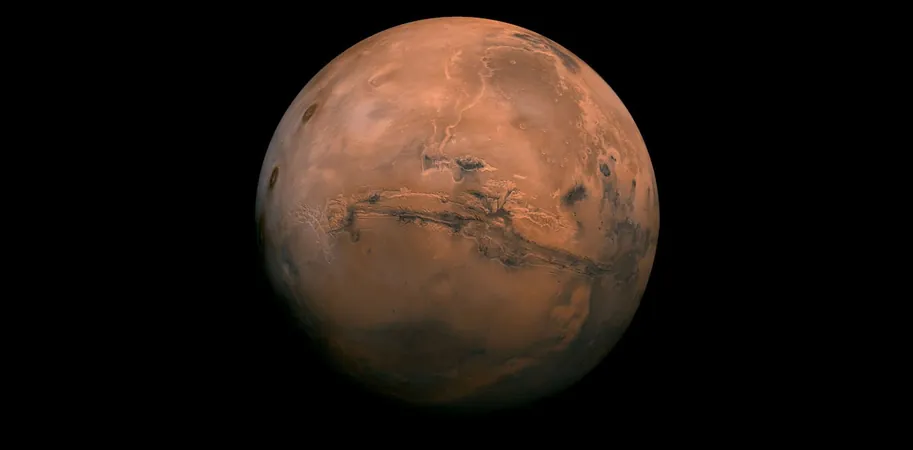
Stunning New Evidence Suggests Mars Was Wet From the Start!
2024-11-22
Author: Ming
Water is critical for life, a fact that is overwhelmingly true on Earth, where roughly 70% of the surface is covered in water. Geological studies reveal that water has been stable on our planet for around 4.3 billion years. In stark contrast, the question of Mars' watery past remains a subject of intense debate. Understanding when water first appeared on the red planet and how long it lingered is pivotal to inquiries about the possibility of ancient Martian life.
Recent research focused on a mineral called zircon found in a Martian meteorite, revealing intriguing evidence that water existed when the zircon formed approximately 4.45 billion years ago. This groundbreaking study published in the journal Science Advances could represent the oldest indicator of water on Mars.
A Watery Martian Past?
Water's role in ancient Mars has long been acknowledged, particularly when we delve into the planet's geological history, which is segmented into four main periods:
1. The Amazonian Era (from present to 3 billion years ago) 2. The Hesperian Period (3 to 3.7 billion years ago) 3. The Noachian Epoch (3.7 to 4.1 billion years ago) 4. The Pre-Noachian Era (4.1 to 4.5 billion years ago)
The journey to uncover water on Mars began in the 1970s with NASA's Mariner 9 spacecraft, which captured images of river valleys on the Martian surface. Subsequent missions, such as the Mars Global Surveyor and Mars Express, further confirmed the presence of hydrated clay minerals across the surface, necessitating the earlier existence of water in that environment.
The Noachian terrains, covering nearly 45% of the Martian surface, reveal the planet's river valleys and clay minerals, while the Hesperian terrains showcase massive flood channels, hints of transient water flow possibly due to groundwater release. Most evidence of liquid water, however, stems from materials dated older than 3 billion years, with no definitive indications of stable bodies of water since.
Peering Back to Pre-Noachian Mars
To understand when water first emerged on Mars, researchers utilize three primary methods: orbiting spacecraft observations, ground-based rover surveys, and the analysis of Martian meteorites that have recently landed on Earth.
A particularly exciting meteorite named NWA7034, nicknamed "Black Beauty," stands out as one of the select samples that contain Pre-Noachian material. This meteorite consists of Martian regolith and zircon crystals that formed between 4.48 and 4.43 billion years ago, making them some of the oldest remnants of Martian history.
In investigating these ancient zircon minerals, scientists discovered evidence of hydrothermal processes. The presence of specific trace elements tells a story of exposure to hot water during their formation millions of years ago.
Hydrothermal Activity and Habitable Conditions
The zircon crystals studied are approximately 4.45 billion years old and contain distinct patterns of iron, aluminum, and sodium. Such layers suggest that these elements were assimilated during the zircon's formation in magma—a rare occurrence in crystalline igneous zircon. The surprising presence of these elements hints at a hydrothermal origin shaped by hot water.
In terrestrial geology, locations like the Olympic Dam in South Australia showcase where hydrothermal systems concentrate metals, indicating potential for similar conditions on ancient Mars. These findings strengthen the theory that early Mars was not only wet but possibly held the conditions necessary for ore deposits to form.
Prior studies have also insinuated a humid Pre-Noachian era on Mars. Investigations into the isotopic ratios within other zircon samples allude to an early hydrosphere, presenting the idea of a Martian ocean at that time.
While it's still unclear if surface water was stable during this epoch, the study suggests that hydrothermal activity was prevalent during Mars' crustal formation. This revelation reveals a tantalizing possibility: Mars had water shortly after its creation, pointing to conditions ripe for habitability.
Conclusion: Is Mars the New Frontier for Life?
As we continue to unravel the mysteries of our neighboring planet, this evidence propels the idea that Mars may have harbored life-supporting conditions far earlier than we once thought. With each new discovery, we inch closer to understanding not just the history of Mars, but its potential to foster life, sparking excitement in the realms of astrobiology and planetary exploration! So, is Mars the new frontier for discovering extraterrestrial life? Keep your eyes on this red planet—it may just hold the key to our cosmic questions!

 Brasil (PT)
Brasil (PT)
 Canada (EN)
Canada (EN)
 Chile (ES)
Chile (ES)
 España (ES)
España (ES)
 France (FR)
France (FR)
 Hong Kong (EN)
Hong Kong (EN)
 Italia (IT)
Italia (IT)
 日本 (JA)
日本 (JA)
 Magyarország (HU)
Magyarország (HU)
 Norge (NO)
Norge (NO)
 Polska (PL)
Polska (PL)
 Schweiz (DE)
Schweiz (DE)
 Singapore (EN)
Singapore (EN)
 Sverige (SV)
Sverige (SV)
 Suomi (FI)
Suomi (FI)
 Türkiye (TR)
Türkiye (TR)